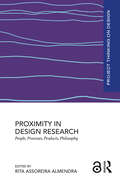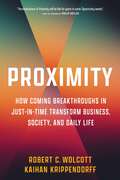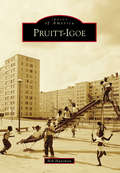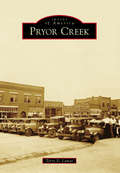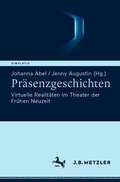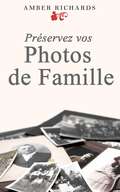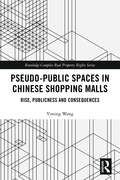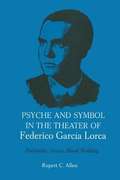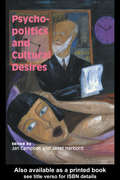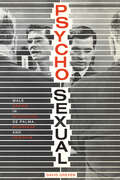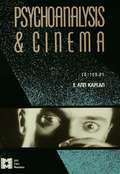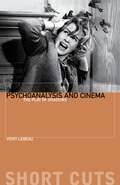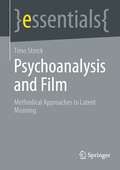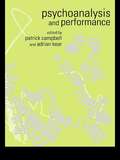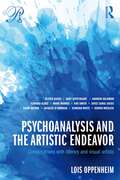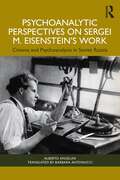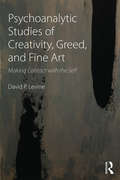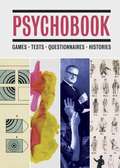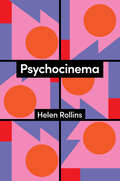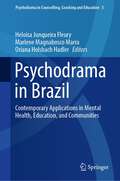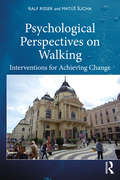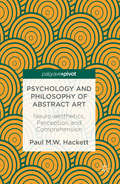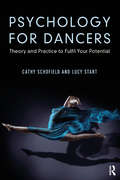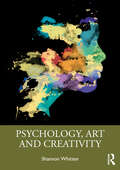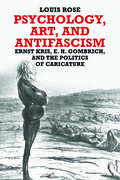- Table View
- List View
Proximity in Design Research: People, Processes, Products, Philosophy (Project Thinking on Design)
by Rita Assoreira AlmendraProximity in Design Research explores four constituents of design: people, processes, products and philosophy, and their potential to bridge contemporary gaps through multilevel synergies.The book brings together a variety of design approaches on several scales developed in the collaboration of different agencies and within diverse contexts. Proximity prompts us to explore the challenges and opportunities for research in design, with the widening and closing of distances in unpredictable times such as those during the COVID-19 pandemic. Despite the social distance imposed during this unprecedented global health scenario, researchers and professionals across different areas of knowledge have engaged in an extraordinary interdisciplinary and transdisciplinary global cooperation. This reinvented proximity enhanced the ability to cross fields, remove boundaries to collaboration between disciplines and accelerate processes towards an overarching goal: to overcome adversity. This edited collection reflects on what designers have taken from this experience so far and the possibilities that are foreseen as the concept of proximity is redefined.This book offers critical knowledge related to both design practice and design theory. It will be of interest to researchers, teachers and students working in the design disciplines.
Proximity: How Coming Breakthroughs in Just-in-Time Transform Business, Society, and Daily Life
by Kaihan Krippendorff Robert C. WolcottWhat if you could have whatever you want, produced and provided immediately and affordably no matter how customized—with minimal environmental impact? Products, services, and experiences on demand. Just-in-time anything, anywhere, anytime. This radical change is underway, as digital technologies push the production and provision of value ever closer to the moment of demand.Robert C. Wolcott and Kaihan Krippendorff provide an indispensable guide to the Proximity revolution, showing how it’s transforming every industry—and our lives. Offering unparalleled foresight for leaders and innovators, they reveal how pervasive this trend will be. Proximity represents an entirely new way to serve customers, with critical implications for corporate strategy, investing, public policy, supply chain resilience, and sustainability. Incremental changes to existing business models won’t suffice.Through interviews and compelling examples, Proximity shares stories of the people and companies leading the way. The book places rapidly advancing technologies—from generative AI and 3D printing to lab-grown meats, renewable energy, and virtual reality—in context and explores the factors accelerating the transformation.Proximity offers a playbook for business leaders, investors, and entrepreneurs to win this rapidly emerging game—and for each of us to consider the implications for our careers, families, communities, and lives.
Pruitt-Igoe (Images of America)
by Bob HansmanIn the early 1950s, Pruitt-Igoe, a vast public housing project, arose on 57 acres on the near north side of St. Louis. Barely 20 years after construction, the 33 eleven-story buildings that made up the complex were razed, and the vacant land that was once home to thousands of people was gradually reclaimed by a dense, neglected urban forest. What happened in-between is a story that tempts but also defies simple narratives. It is a story of interweaving and competing accounts, both then and now. This volume approaches Pruitt-Igoe with all of its contradiction in mind. Alongside iconic images, other seldom-seen photographs flesh out the history in sometimes surprising ways and, in doing so, preserve some of the stories that are in danger of being permanently erased and lost, just as Pruitt-Igoe was.
Pryor Creek (Images of America)
by Terry D. LamarPryor Creek, originally named Coo-y-yah (Cherokee for "huckleberry"), incorporated as a city in 1894. Also known as Pryor by the US Postal Service, it is located in northeastern Oklahoma and is the seat of Mayes County. The community is rich with history that dates back to its early days as Indian Territory, where many early residents settled after suffering a grueling journey on the Trail of Tears from the old Cherokee Nation. After starting as a rural farming community, with the addition of the railroad in 1870 Pryor Creek grew to become a major industrial economic force in the region following World War II. During the war, the area was home to a massive ammunition ordnance plant, which eventually became the largest industrial park in Oklahoma. In 1942, Pryor Creek's downtown business district was destroyed by the fifth-deadliest tornado in Oklahoma history. Pryor Creek is also a "gateway" known for its regional lakes and recreational areas.
Präsenzgeschichten: Virtuelle Realitäten im Theater der Frühen Neuzeit (Simulatio. Theatertechniken in Literatur, Medien und Wissenschaft)
by Jenny Augustin Johanna AbelBei einem Blick auf virtuelle Realitäten im frühneuzeitlichen Theater gilt es, unsere vom digitalen Zeitalter geprägten Konzepte der Virtualität und Präsenz zu revidieren. Auf dem Gebiet der Kulturen der Romania haben multiple Präsenz- und Virtualitätsverständnisse eine lange und kontroverse Geschichte. In der Auseinandersetzung mit der Vorgeschichte erweiterter Realitätserfahrungen am Modell des Theaters geht es vor allem um die Einbettung von Vergegenwärtigungstechniken in verflochtene Geschichten und vielschichtige Narrationen vom wirkmächtig Virtuellen. Hier werden daher Präsenzgeschichten im Plural in diversen Medien und epistemischen Erzeugungskontexten durchgespielt.
Préservez Vos Photos De Famille
by Amber Richards Chimène ElessaVos photos de famille ont certainement de l’importance pour vous. Grâce au présent guide, vous ne prendrez pas le risque de prendre à tout jamais ces trésors irremplaçables. En effet, nos photos de famille sont des biens inestimables. Ce sont les archives visuelles de nos souvenirs et de nos proches. Elles méritent un soin particulier pour durer longtemps et pour pouvoir être transmises à la génération suivante. De nombreuses personnes qui s’intéressent à la généalogie possèdent des collections de photos de famille vintage qui, pour être préservées, doivent être entretenues de façon encore plus soignée. Suivez les étapes pratiques pour protéger vos photos de famille, qu’elles soient classiques ou en format numérique. Assurez-vous la longévité de vos trésors et évitez de faire face à leur perte tragique. Téléchargez dès maintenant votre exemplaire.
Pseudo-Public Spaces in Chinese Shopping Malls: Rise, Publicness and Consequences (Routledge Complex Real Property Rights Series)
by Yiming WangShopping malls in China create a new pseudo-public urban space which is under the control of private or quasi-public power structure. As they are open for public use, mediated by the co-mingling of private property rights and public meanings of urban space, the rise, publicness and consequences of the boom in the construction of shopping malls raises major questions in spatial political economy and magnifies existing theoretical debates between the natural and conventional schools of property rights. In examining these issues this book develops a theoretical framework starting with a critique of the socio-spatial debate between two influential bodies of work represented by the work of Henri Lefebvre and David Harvey. Drawing on the framework, the book examines why pseudo-public spaces have been growing so rapidly in China since the 1980s; assesses to what degree pseudo-public spaces are public, and how they affect the publicness of Chinese cities; and explores the consequences of their rise. Findings of this book provide insights that can help to better understand Chinese urbanism and also have the potential to inform urban policy in China. This book will be of interest to academics and researchers in both Chinese studies and urban studies.
Psyche and Symbol in the Theater of Federico García Lorca: Perlimplín, Yerma, Blood Wedding
by Rupert C. AllenSymbol and psyche are twin concepts in contemporary symbological studies, where the symbol is considered to be a "statement" by the psyche. The psyche is a manifold of conscious and unconscious contents, and the symbol is their mediator. Because Lorca's dramatic characters are psychic entities made up of both conscious and unconscious elements, they unfold, grow, and meet their fate in a dense realm of shifting symbols.
Psycho-Politics And Cultural Desires
by Jan Campbell Jan HarbordA cultural studies textbook that deals with issues of methodology, as well as mapping out the history and theories and ideas in cultural studies. The book examines the work of Raymond Williams, Lacan and Hoggart, among Others, And Explores Notions Of Subculture, Psychoanalysis, Marxist thought, narrative, autobiography, fiction, subjectivity, language, history and representation. The book focuses on the past, present and future of cultural studies, with the aim of providing readers with a clear overview of the central ideas within the area, developing current debates and possible future avenues.
Psycho-Sexual: Male Desire in Hitchcock, De Palma, Scorsese, and Friedkin
by David GrevenBridging landmark territory in film studies, Psycho-Sexual is the first book to apply Alfred Hitchcock’s legacy to three key directors of 1970s Hollywood—Brian De Palma, Martin Scorsese, and William Friedkin—whose work suggests the pornographic male gaze that emerged in Hitchcock’s depiction of the voyeuristic, homoerotically inclined American man. Combining queer theory with a psychoanalytic perspective, David Greven begins with a reconsideration of Psycho and the 1956 remake of The Man Who Knew Too Much to introduce the filmmaker’s evolutionary development of American masculinity. Psycho-Sexual probes De Palma’s early Vietnam War draft-dodger comedies as well as his film Dressed to Kill, along with Scorsese’s Taxi Driver and Friedkin’s Cruising as reactions to and inventive elaborations upon Hitchcock’s gendered themes and aesthetic approaches. Greven demonstrates how the significant political achievement of these films arises from a deeply disturbing, violent, even sorrowful psychological and social context. Engaging with contemporary theories of pornography while establishing pornography’s emergence during the classical Hollywood era, Greven argues that New Hollywood filmmakers seized upon Hitchcock’s radical decentering of heterosexual male dominance. The resulting images of heterosexual male ambivalence allowed for an investment in same-sex desire; an aura of homophobia became informed by a fascination with the homoerotic. Psycho-Sexual also explores the broader gender crisis and disorganization that permeated the Cold War and New Hollywood eras, reimagining the defining premises of Hitchcock criticism.
Psychoanalysis and Cinema (AFI Film Readers)
by E. Ann KaplanThese fifteen carefully chosen essays by well-known scholars demonstrate the vitality and variety of psychoanalytic film criticism, as well as the crucial role feminist theory has played in its development. Among the films discussed are Duel in the Sun, The Best Years of Our Lives, Three Faces of Eve, Tender is the Night, Pandora's Box, Secrets of the Soul, and the works of Jacques Tourneur (director of The Cat People and other features).
Psychoanalysis and Cinema: The Play of Shadows (Short Cuts)
by Vicky LebeauLebeau examines the long and uneven history of developments in modern art, science, and technology that brought pychoanalysis and the cinema together towards the end of the nineteenth century. She explores the subsequent encounters between the two: the seductions of psychoanalysis and cinema as converging, though distinct, ways of talking about dream and desire, image and illusion, shock, and sexuality. Beginning with Freud's encounter with the spectacle of hysteria on display in fin-de-siècle Paris, this study offers a detailed reading of the texts and concepts which generated the field of psychoanalytic film theory.
Psychoanalysis and Film: Methodical Approaches to Latent Meaning (essentials)
by Timo StorckThis essential is dedicated to the connection between psychoanalysis and film. Psychoanalysis is suitable for a methodically guided film viewing. This is not an application of psychoanalytical theory, but rather an application of its method of a reflected relationship to a counterpart. In this way, latent meanings can be taken into consideration and an interpretation can be developed. This essential reconstructs the possibilities of such an approach and presents existing approaches. Finally, a guideline for carrying out a film psychoanalytical interpretation is proposed. Numerous film examples serve to illustrate this.The translation was done with the help of artificial intelligence. A subsequent human revision was done primarily in terms of content.
Psychoanalysis and Performance
by Adrian Kear Patrick CampbellThe field of literary studies has long recognised the centrality of psychoanalysis as a method for looking at texts in a new way. But rarely has the relationship between psychoanalysis and performance been mapped out, either in terms of analysing the nature of performance itself, or in terms of making sense of specific performance-related activities. In this volume some of the most distinguished thinkers in the field make this exciting new connection and offer original perspectives on a wide variety of topics, including: · hypnotism and hysteria · ventriloquism and the body · dance and sublimation · the unconscious and the rehearsal process · melancholia and the uncanny · cloning and theatrical mimesis · censorship and activist performance · theatre and social memory. The arguments advanced here are based on the dual principle that psychoanalysis can provide a productive framework for understanding the work of performance, and that performance itself can help to investigate the problematic of identity.
Psychoanalysis and the Artistic Endeavor: Conversations with literary and visual artists (Psychoanalysis in a New Key Book Series)
by Lois OppenheimPsychoanalysis and the Artistic Endeavor offers an intriguing window onto the creative thinking of several well-known and highly creative individuals. Internationally renowned writers, painters, choreographers, and others converse with the author about their work and how it has been informed by their life experience. Creative process frames the discussions, but the topics explored are wide-ranging and the interrelation of the personal and professional development of these artists is what comes to the fore. The conversations are unique in providing insight not only into the art at hand and into the perspective of each artist on his or her own work, but into the mind from which the work springs. The interviews are lively in a way critical writing by its very nature is not, rendering the ideas all that much more accessible. The transcription of the live interview reveals the kind of reflection censored elsewhere, the interplay of personal experience and creative process that are far more self-consciously shaped in a text written for print. Neither private conversation nor public lecture, neither crafted response (as to the media) nor freely associative discourse (as in the analytic consulting room), these interviews have elements of all. The volume guides the reader toward a deeper psychologically oriented understanding of literary and visual art, and it engages the reader in the honest and often-provocative revelations of a number of fascinating artists who pay testimony to their work in a way no one else can. This is a unique collection of particular interest for psychoanalysts, scholars, and anyone looking for a deeper understanding of the creative process.
Psychoanalytic Perspectives on Sergei M. Eisenstein's Work: Cinema and Psychoanalysis in Soviet Russia
by Alberto AngeliniIn this insightful book, Alberto Angelini shows the influence of psychoanalysis and psychology on Sergei M. Eisenstein, one of the most celebrated Russian directors, and his cinematic output. Angelini situates Eisenstein’s life and oeuvre in the history and culture of twentieth-century Russia, drawing clear parallels between his networking with key figures such as Lev Vygotsky and Aleksandr Luria. He utilises the tools of psychology with the insight of psychoanalysis to illuminate the ways in which Eisenstein understood art as an anthropological enterprise while maintaining the same dialectical philosophy as the director in highlighting the many disciplines and figures that he drew inspiration from. Angelini also looks in depth at the influence psychoanalytic theories of regression had on Eisenstein’s approach to art, while examining the impact Stalinism had directly on both Eisenstein and psychoanalysis at large from the 1930s onwards. This book is an essential resource for psychoanalysts, students, and scholars of film studies, as well as those interested in the intersection between psychoanalytic theory, cinema, and the arts.
Psychoanalytic Studies of Creativity, Greed, and Fine Art: Making Contact with the Self
by David P LevineThroughout the history of psychoanalysis, the study of creativity and fine art has been a special concern. Psychoanalytic Studies of Creativity, Greed and Fine Art: Making Contact with the Self makes a distinct contribution to the psychoanalytic study of art by focusing attention on the relationship between creativity and greed. This book also focuses attention on factors in the personality that block creativity, and examines the matter of the self and its ability to be present and exist as the essential element in creativity. Using examples primarily from visual art David Levine explores the subjects of creativity, empathy, interpretation and thinking through a series of case studies of artists, including Robert Irwin, Ad Reinhardt, Susan Burnstine, and Mark Rothko. Psychoanalytic Studies of Creativity, Greed and Fine Art explores the highly ambivalent attitude of artists toward making their presence known, an ambivalence that is evident in their hostility toward interpretation as a way of knowing. This is discussed with special reference to Susan Sontag's essay on the subject of interpretation. Psychoanalytic Studies of Creativity, Greed and Fine Art contributes to a long tradition of psychoanalytically influenced writing on creativity including the work of Deri, Kohut, Meltzer, Miller and Winnicott among others. It will be of interest to psychoanalysts, psychoanalytic psychotherapists, historians and theorists of art.
Psychobook: Games, Tests, Questionnaires, Histories
by Lionel Shriver Wall Oison Mel Gooding Julian RothensteinWho knew a trip to the therapist could be so much fun, even aesthetically rewarding? Beyond sharing feelings or complaining about your mother, Psychobook reveals the rich history of psychological testing in a fascinating sideways look at classic testing methods, from word-association games to inkblots to personality tests.Psychobook includes never-before-seen content from long-hidden archives, as well as reimagined tests from contemporary artists and writers, to try out yourself, at home or at parties. A great ebook for the therapist in your life and the therapist in you, for anyone interested in the history of psychology and psychological paraphernalia, or for anyone who enjoys games and quizzes. Psychobook will brighten your day and outlook.
Psychocinema (Theory Redux)
by Helen RollinsPsychocinema reexamines the connection between psychoanalysis and film, arguing for a return to the universalist core of both cinema and subjectivity. It traces the history of the influence of psychoanalysis on cinema and shows how the detour into ideologies of identity and difference eclipses the premise of the first and the emancipatory power of the second.The book argues that psychoanalysis does not simply help us elucidate what we see on screen: rather, there is a fundamental relationship between the structure of psychoanalysis and that of cinema. Cinema acts upon the viewer like psychoanalysis upon the analysand and can expose them to the universal Lack inherent in their desire. This process undermines the unconscious logic of capitalism, which relies on a promise in fulfilment.Rollins, a filmmaker, shows how reductive interpretations of psychoanalytic film theory have permeated film education and film practice and have affected the way films are made and watched, to the detriment of contemporary philosophy and politics. Psychocinema urges filmmakers, theorists and audiences to embrace the truly radical and emancipatory potential of cinema: its capacity to confront us with the universal Lack in our desire.
Psychodrama in Brazil: Contemporary Applications in Mental Health, Education, and Communities (Psychodrama in Counselling, Coaching and Education #3)
by Heloisa Junqueira Fleury Marlene Magnabosco Marra Oriana Holsbach HadlerThis book approaches contemporary psychodrama from many contexts and population application from different regions of Brazil. It presents the diversity of local culture, the originality with which psychodramatic philosophy emerges in the Brazilian scenario. It introduces the theoretical-methodological procedures that reaffirm psychodrama as a scientific instrument of social action. The chapters cover the philosophical and theoretical foundations and the new socio-psycho-educational methodologies applied in clinical practices, sociotherapy, politics and society. It is a helpful resource for professionals and academics interested in the development of innovative applications of Psychodrama.
Psychological Perspectives on Walking: Interventions for Achieving Change
by Ralf Risser Matúš ŠuchaPsychological Perspectives on Walking provides a comprehensive overview of the benefits of walking and shows how we can encourage people to walk more based on psychological principles. It examines how walking significantly improves health, positively impacts the environment, contributes to resolving social issues, and boosts the local micro-economy. This pioneering book discusses psychological motivations for walking versus not walking and asserts research-based arguments in favour of walking, including both theoretical considerations and everyday concerns. The book investigates the motivations that can lead to increased walking, advises on how to build walking-conducive habits, and recommends strategies for decision makers for promoting changes that will allow walking to thrive more easily. The authors include success stories and lessons learned from what have become known as 'walkable' cities to show how interventions and initiatives can succeed on a practical basis. This accessible, practical book is essential for urban planners; health specialists; policy makers; traffic experts; psychology, civil engineering, and social sciences students; and experts in the field of sustainable mobility. Psychological Perspectives on Walking will appeal to anyone in the general population in favour of a sustainable and healthy lifestyle.
Psychology and Philosophy of Abstract Art
by Paul M.W. HackettThis book examines how we perceive and understand abstract art in contrast to artworks that represent reality. Philosophical, psychological and neuroscience research, including the work of philosopher Paul Crowther, are considered and out of these approaches a complex model is developed to account for this experience. The understanding embodied in this model is rooted in facet theory, mapping sentences and partially ordered analyses, which together provide a comprehensive understanding of the perceptual experience of abstract art.
Psychology for Dancers: Theory and Practice to Fulfil Your Potential
by Cathy Schofield Lucy StartPsychology for Dancers: Theory and Practice to Fulfil Your Potential examines how psychological theory can be related to dance practice. Aimed at the dancer who wants to maximize their potential but has no grounding in psychology, the book begins with an examination of basic psychological concepts, approaches and methods, before applying theory to dance. The book explores why dance is so important in many people’s lives: as a form of fitness, a profession, or visual entertainment. Each chapter then examines a different aspect of psychology related to dance in an applied context. Self-perception is examined as dancers are under great scrutiny; a grounded sense of self will ensure a positive perception of self-worth and body image, and suggestions are made as to how a healthy and motivational climate can be created. The book also places an emphasis on how cognitive skills are as important as technical skills, including the ability to learn and recall steps and choreography as efficiently as possible. Social factors are related to the dance context, with a discussion of effective leadership and communication skills and the importance of group cohesion. Finally, there is a review of the impact of emotions on dance practice and how best to manage these emotions. Each chapter reviews important psychological theories, offering practical suggestions on how they can be applied to dance practice. Psychology for Dancers is an invaluable resource for students, professionals, and teachers of dance.
Psychology, Art and Creativity
by Shannon WhittenThis comprehensive text challenges the taken-for-granted opposition of science and art by combining the fundamental principles of psychology, art and creativity and presenting the interdependent disciplines together in one unique, clear, and accessible resource. The author, Shannon Whitten, begins with an introduction to the foundations of art and psychology, providing readers with a critical understanding and history of the key concepts in both disciplines before establishing their interdependency. Drawing on a solid evidence base, the book then presents an assortment of extensive topics, from the human perception of color to the ability of art to impact mental health. The exploration of these topics enables the reader to reflect on the phenomenal power of human creativity. The chapters include vital categories of human psychology such as emotion, perception, personality, and social psychology to show the extensive connections between these elements of experience and art. Featuring a wealth of additional resources, this illuminating text equips the reader with a sound knowledge of the vocabulary and issues in the study of empirical aesthetics through visual content and stimulating prompts for reflection. Emphasizing the link between creativity and good mental health, the book is an essential read for students of the psychology of art, creativity, art therapy, and empirical aesthetics, as well as any discipline within the humanities, arts and science. It will also be of relevance to anyone interested in understanding the psychology behind creativity and its therapeutic effects on the artist.
Psychology, Art, and Antifascism: Ernst Kris, E. H. Gombrich, and the Politics of Caricature
by Louis RoseA vivid portrait of two remarkable twentieth-century thinkers and their landmark collaboration on the use and abuse of caricature and propaganda in the modern world In 1934, Viennese art historian and psychoanalyst Ernst Kris invited his mentee E. H. Gombrich to collaborate on a project that had implications for psychology and neuroscience, and foreshadowed their contributions to the Allied war effort. Their subject: caricature and its use and abuse in propaganda. Their collaboration was a seminal early effort to integrate science, the humanities, and political awareness. In this fascinating biographical and intellectual study, Louis Rose explores the content of Kris and Gombrich's project and its legacy.
